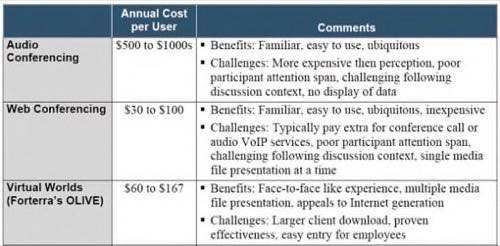Forterra Systems, a company aiming to bring virtual world technology to enterprises, will shortly release a report entitled Recipe for Success with Enterprise Virtual Worlds. ReadWriteWeb was given an exclusive first look at the report. It is based on pilots conducted with consulting firms Accenture and ACS, using Forterra’s virtual world product called OLIVE (On-Line Interactive Virtual Environment). One of the more interesting conclusions of the report is that virtual worlds are both more engaging and less expensive to operate than audio and web conference systems. Although as we shall see, there are still I.T. and usability issues with virtual worlds – which Forterra and other vendors will need to overcome.

There’s been a lot of speculation – and hype – about using virtual worlds for enterprise learning and collaboration. In January we analyzed a Forrester report into the use of virtual worlds in the workplace, which claimed that “within five years, the 3-D Internet will be as important for work as the Web is today”. However at that point there seemed to be much work to do before virtual world software became user friendly to the enterprise crowd – “you’ve practically got to be a gamer to use most of these tools”, Forrester noted in January. Even so, Forrester cited some big names who were investing in this technology: BP, IBM, Intel, and the US Army.
The multi-million dollar question of course is: can a virtual world ever be a serious enterprise tool, or is it destined to remain merely a fun thing that powers Coca-Cola’s website? Forterra’s report at least shows glimpses of how enterprises can use virtual worlds.
Let’s quickly explain what Forterra does. Its main product is OLIVE (On-Line Interactive Virtual Environment), which it describes as “an open, distributed client-server platform for building virtual worlds”. OLIVE features an API, licensable 3D content, 3rd party system integrations, and tools to create and edit virtual world content.
Virtual Worlds Compared to Web Conferencing
Forterra includes this graph in the report, comparing virtual worlds to audio and video web conferencing:

If the graph is to be believed, and we must remind you that it was created by a virtual worlds vendor, then virtual world technology isn’t much more expensive for enterprises to deploy than web conferencing. The last two challenges listed for virtual worlds though are pretty key: “proven effectiveness” and “easy entry for employees”. The Forrester report had suggested that usability in particular was an issue. To be fair, Forterra acknowledges those challenges and more in the report.
How ACS Tested Virtual Worlds for Training
The two use cases Forterra conducted, with Accenture and ACS, concluded that there was interest in exploring the technology more for business use. ACS, which is a $6.2 billion
FORTUNE 500 consulting company with 63,000 employees, tested Forterra’s technology for virtual training with one of their big 4 accounting clients who have
extensive global training requirements. One of ACS’ testers commented that they “see this [virtual worlds] becoming even more of a viable option for training with the advent of
the next generation of network speeds and the continued increase in the
capability of computers. The graphics will only become better and the world
more immersive — and with those changes, an even better fit for
distance/remote learning.”

Another comment from ACS was that “while 3D learning may not completely replicate the effectiveness of a face-to-face
experience, companies will be challenged to consider that for some course
topics, a slightly reduced effectiveness is worth the savings, risks, and work efficiency gained through deployment of learning in 3D.” [emphasis ours]
Conclusion: Watch This Space
So enterprises are becoming more interested in virtual worlds. The pilots showed that there are still challenges deploying the technology, but even so it is seen as a cost-effective future option for training and collaboration.
Although we still aren’t seeing major deployments within enterprises – and there is no indication in Forterra’s report of this changing in the near future – it’s a space to watch in 2009-10.










